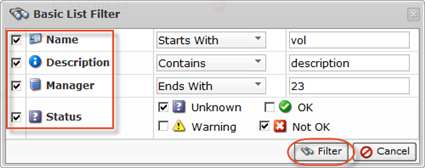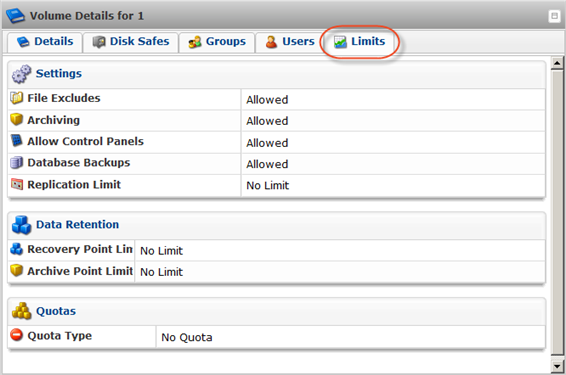Server Backup Manager Data Center Console allows you to monitor volume parameters on multiple Server Backup Managers at once from the Volumes window.
To monitor volumes:
In the Main menu, click Volumes. Server Backup Manager displays the Volumes window as shown in the following image.

Using the Volumes list
SBM displays a list of all volumes including the following columns:
- Status. Displays the volume status. For more information about the different volume statuses available, see Use Data Center Console Dashboard.
- Name. Displays the volume name. SBM uses the volume name to identify the volume in the system.
- Backup Manager. Displays the name/IP of the backup manager to which the current volume belongs.

Note
The backup manager name/IP is displayed in the form of a link. You can click the link for quick access to the backup manager.

- Quota Type. Displays the type of quota assigned to the volume. If no quota is defined for the volume, then Server Backup Manager displays a red icon. Set a quota to limit the disk usage of the volume. The limit is set for all disk safes in the volume on the basis of space occupied by the disk safes, the size of deltas, or the number of deltas.

Tip
You can define disk quotas in Configuration. For more information about configuring disk quotes, see Configure Manager Options.
- Soft Quota. Displays the warning quota value in bytes or deltas. The soft quota is a warning level that informs users that they are close to reaching their effective limit.
- Hard Quota. Displays the stopping quota value in bytes or in deltas. The hard quota allows you to store data in resources until you reach the Hard Quota. At that point, the system forbids generation of new recovery points. The replication is interrupted and failed.
- On Disk Size. Displays the disk space occupied by the volume in bytes.
- Deltas. Displays the byte value of data that changed since the last backup ran.
- Actions. Displays the list of actions available over the volume.
| Tip Use the page navigation icons to look through the Volumes list more efficiently.  |
Available volume actions
The Volumes list contains the Actions pane, as shown in the following image.

Server Backup Manager allows you to perform the following actions:
| Icon | Action | Description |
|---|---|---|
 |
Edit | Allows you to edit the volume properties. For more information about editing volumes, see Edit volumes in DCC. |
 |
Remove | Allows you to delete the volume configuration from the Console. All backed up data remains on the disk and the volume folder is kept. |
 |
Delete | Allows you to delete the volume from the Console. |
Filtering the Volumes list
Basic List Filter
To sort the Volumes list:
- In the Volumes menu, click Basic List Filter. Server Backup Manager displays the Basic List Filter dialog box.
- Select the necessary options, and then click Filter as shown in the following image.

If you want to discard filtering options and view the whole list, click Show All.
Advanced List Filter
The Advanced List Filter allows you to reduce the number of volumes in the list on the basis of all possible filter options.
To apply the Advanced Filter to the Volumes list:
- In the Volumes menu, click Advanced List Filter. SBM displays the Advanced List Filter dialog box as shown in the following image.

You can hide/open the filter options for every block by clicking on the header of the corresponding block. - Define one or more of the following filter options:
-
- Name. Check this box to filter the list by the volume name.
- Description. Check this box to filter the list by the volume description.
- Volume Path. Check this box to filter the list by the volume path.
- Soft Quota. Check this box to filter the list by the soft quota defined for the volumes.
- Hard Quota. Check this box to filter the list by the hard quota defined for the volumes.
The following items are available in the drop-down list:
-
- Starts with. Allows you to filter by name/description that begins with a specific character(s). Type in the beginning characters of the name or description.
- Contains. Allows you to filter by name/description that has specific character(s) anywhere in the text. Type in characters that can be contained in the name or description.
- Ends with. Allows you to filter by name/description that ends with a specific character(s). Type in the ending characters of the name or description.
- Min...bytes (for Soft and Hard Quotas) - Allows you to filter by soft or hard quota of the defined minimum size in bytes.
- Max...bytes (for Soft and Hard Quotas) - Allows you to filter by soft or hard quota of the defined maximum size in bytes.
3. Click Filter to apply the search filter.
| Tip Click Show all to see the whole list of volumes.  |
Details Pane
The Details pane provides more detailed information about the volume selected in the list on the top. The pane has three tabs:
- Details
- Groups
- Users
Details tab
Most of the information presented in the Details tab is the same as the data shown in the Volumes list columns. For more information about server details, see Access Backup Managers in DCC.
If you click the Detail icon near the backup manager name, you can access the backup manager details window as shown in the following image.

Disk Safes tab
The Disk Safes tab displays the list of disk safes assigned to the volume.

Groups Tab
The Groups tab displays the list of groups assigned to the volume.

Users Tab
The Users tab displays the list of users assigned to the volume.

Limits Tab
The Limits tab displays quotas, data retention rules, and permission settings.

Quotas
- Quota Type. Quotas are set to limit the disk usage of the volume. You can select whether the quota is on the disk size or the size of the deltas in the disk safe.
- Soft Quota. Displays the value in bytes, KB, MB, GB or TB. Soft quota is a warning level where users are informed that they are close to reaching their effective limit.
- Hard Quota. - Displays the value in bytes, KB, MB, GB or TB. Maximum resources allowed to be occupied by data.
